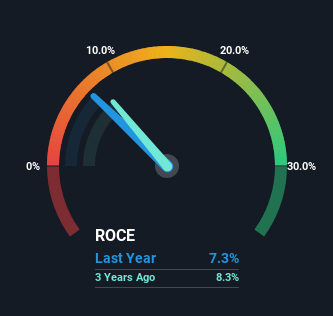- Japan
- /
- Basic Materials
- /
- TSE:5283
Takamisawa (TSE:5283) Shareholders Will Want The ROCE Trajectory To Continue
Finding a business that has the potential to grow substantially is not easy, but it is possible if we look at a few key financial metrics. Ideally, a business will show two trends; firstly a growing return on capital employed (ROCE) and secondly, an increasing amount of capital employed. If you see this, it typically means it's a company with a great business model and plenty of profitable reinvestment opportunities. So on that note, Takamisawa (TSE:5283) looks quite promising in regards to its trends of return on capital.
Understanding Return On Capital Employed (ROCE)
For those who don't know, ROCE is a measure of a company's yearly pre-tax profit (its return), relative to the capital employed in the business. The formula for this calculation on Takamisawa is:
Return on Capital Employed = Earnings Before Interest and Tax (EBIT) ÷ (Total Assets - Current Liabilities)
0.073 = JP¥1.6b ÷ (JP¥40b - JP¥18b) (Based on the trailing twelve months to March 2024).
Thus, Takamisawa has an ROCE of 7.3%. On its own, that's a low figure but it's around the 8.2% average generated by the Basic Materials industry.
Check out our latest analysis for Takamisawa

While the past is not representative of the future, it can be helpful to know how a company has performed historically, which is why we have this chart above. If you're interested in investigating Takamisawa's past further, check out this free graph covering Takamisawa's past earnings, revenue and cash flow.
What The Trend Of ROCE Can Tell Us
Takamisawa's ROCE growth is quite impressive. The figures show that over the last five years, ROCE has grown 37% whilst employing roughly the same amount of capital. Basically the business is generating higher returns from the same amount of capital and that is proof that there are improvements in the company's efficiencies. The company is doing well in that sense, and it's worth investigating what the management team has planned for long term growth prospects.
On a separate but related note, it's important to know that Takamisawa has a current liabilities to total assets ratio of 46%, which we'd consider pretty high. This effectively means that suppliers (or short-term creditors) are funding a large portion of the business, so just be aware that this can introduce some elements of risk. Ideally we'd like to see this reduce as that would mean fewer obligations bearing risks.
The Bottom Line On Takamisawa's ROCE
In summary, we're delighted to see that Takamisawa has been able to increase efficiencies and earn higher rates of return on the same amount of capital. And investors seem to expect more of this going forward, since the stock has rewarded shareholders with a 91% return over the last five years. Therefore, we think it would be worth your time to check if these trends are going to continue.
Takamisawa does come with some risks though, we found 2 warning signs in our investment analysis, and 1 of those is potentially serious...
For those who like to invest in solid companies, check out this free list of companies with solid balance sheets and high returns on equity.
Valuation is complex, but we're here to simplify it.
Discover if Takamisawa might be undervalued or overvalued with our detailed analysis, featuring fair value estimates, potential risks, dividends, insider trades, and its financial condition.
Access Free AnalysisHave feedback on this article? Concerned about the content? Get in touch with us directly. Alternatively, email editorial-team (at) simplywallst.com.
This article by Simply Wall St is general in nature. We provide commentary based on historical data and analyst forecasts only using an unbiased methodology and our articles are not intended to be financial advice. It does not constitute a recommendation to buy or sell any stock, and does not take account of your objectives, or your financial situation. We aim to bring you long-term focused analysis driven by fundamental data. Note that our analysis may not factor in the latest price-sensitive company announcements or qualitative material. Simply Wall St has no position in any stocks mentioned.
Have feedback on this article? Concerned about the content? Get in touch with us directly. Alternatively, email editorial-team@simplywallst.com
About TSE:5283
Takamisawa
Engages in the manufacture and sale of secondary concrete products, ready-mixed concrete, gravel, sand, cement, and other construction materials in Japan.
Excellent balance sheet established dividend payer.
Market Insights
Community Narratives




